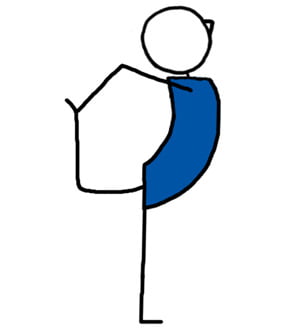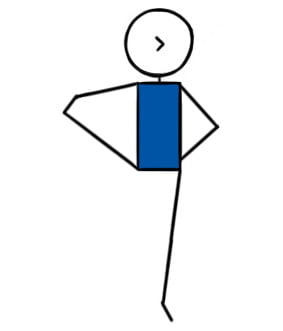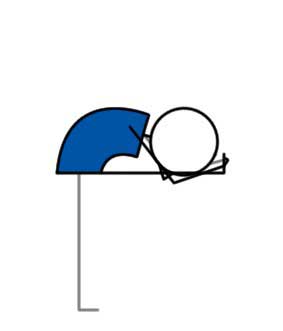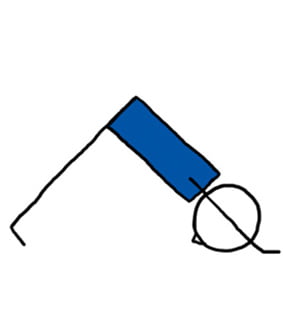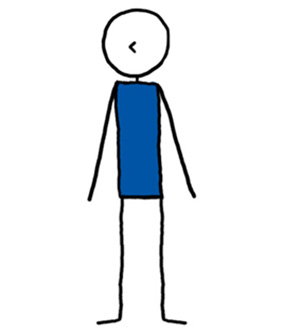
| Category: | Pilates Lesson Planner |
|---|---|
| Sub Category: | |
| Types: | Balance, Forward Bend, Hip Opener, Standing, Strengthen, Stretch |
| Anatomy: | Arms & Shoulders, Biceps & Triceps, Core, Hamstrings, Hips, Lower Back, Middle Back, Psoas, Wrists & Arms |
| Chakras: | Base, Sacral Centre, Solar Plexus Centre |
| Therapy: | Leg Congestion, Poor Posture, Varicose Veins |
| Drishti: | Tip Of Nose |
| Dosha: | Kapha, Pitta, Vata |
Stand tall. Place hands on hips - or one hand on a chair. Bring your weight to the left foot as you raise the right knee in front of the body. Then take it out to the side. Circle 6 times in one direction then 6 times in the other direction. Repeat to the other side.
Stretching quads, hamstrings and buttocks. Hip opener. Oils the hip joint. Improves balance.
A) Strap looped around the sole of the foot instead of hooking big toe with fingers and thumb. B) Raised leg on the back of the chair. C) Use a wall as a prop (to stay in the pose for longer). D) Press raised heel firmly into the wall. E) Do the pose lying down. F) Fold the torso forward toward the lifted leg.
Knee injury.
Click here for lots of FREE downloadable Yoga lesson plans.
Click here for lots of FREE downloadable Pilates lesson plans.
- Berwick Block 2 week 2
- Ask Genie4
- Ask Genie3
- Jan 24 easy class
- Ask Genie1
- Ask Genie2
- full body
- Ask Genie1
- Ask Genie3
- Ask Genie2
- Ask Genie2
- Ask Genie1
- Ask Genie2
- Ask Genie3
- Kickstart easy
- Ask Genie1
- 16 Beginners Intermediate
- Spectrum 8/12
- School 01
- Ask Genie 1
- Hip strength & mobility
- 20-min Cardio for Legs
- Ask Genie 1
- Ask Genie1
- Berwick Block 2 week 1
- Berwick Block 2 week 3
- Berwick Block 2 week 2
- Berwick Block 2 week 4
- 16 Beginners Intermediate
- Berwick Block 2 week 6
- Ask Genie 5
- Ask Genie 9
- Ask Genie 2
- test 2
- Karen's private lesson- Obj Balance & core
- Ask Genie 1
- Ask Genie 1
- pilates Lesson Victory College week 2
- Ask Genie 1
- Ask Genie 2
- Mat Pilates Flow and move Beginner 1 week 1
- Mat Exercises
- Freestyle Pilates Flow 1
- Mat Exercises lesson plan to work on
- Mat Pilates Flow and move Beginner 1 week 1
- Pilates Flow
- Pilates 45 min A
- Ask Genie 2
- Danchi 1
- Mat Pilates Flow 1
- Mat Pilates Flow 1
- Barre & Balance
- Mat Pilates Flow 1
- Mat Pilates Flow 1
- Mat Pilates Flow 1
- Ask Genie 3
- Ask Genie 1
- Beginners 2
- Ask Genie 3
- Ask Genie 1
Standing Hip Rotation Pilates Exercise FAQs
What are the teaching directions for Standing Hip Rotations?
Stand tall. Place hands on hips – or one hand on a chair. Bring your weight to the left foot as you raise the right knee in front of the body. Then take it out to the side. Circle 6 times in one direction then 6 times in the other direction. Repeat to the other side.
What are the main benefits of Standing Hip Rotations?
Stretching quads, hamstrings and buttocks.
Hip opener.
Oils the hip joint.
Improves balance.
What are some modifications for Standing Hip Rotations?
A) Strap looped around the sole of the foot instead of hooking big toe with fingers and thumb.
B) Raised leg on the back of the chair.
C) Use a wall as a prop (to stay in the pose for longer).
D) Press raised heel firmly into the wall.
E) Do the pose lying down.
F) Fold the torso forward toward the lifted leg.
What are some beginner tips for Standing Hip Rotations?
Work on your balance first with the Single Leg Stand and Single Leg Squat, and Single Leg Stand On Wobble Cushion.
Focus on your breath when exiting the exercise. Inhale, and bring your leg back to the centre. Exhale, lower foot back to the floor.
What are the benefits of balance exercises?
Balance is the ability to control your body’s position, whether stationary (i.e. a complex yoga pose) or while moving (e.g. playing golf).
Balance is a key component of Yoga, along with strength and flexibility poses.
Top 5 Benefits Of Balance Exercises:
1) Body Awareness – Body awareness is the sense of how your limbs are oriented in space, also known as proprioception. Balance training improves body awareness, which decreases the likelihood of injury.
2) Coordination – Balance poses require your entire body to work in harmony, otherwise, you will fall or stumble. Improved coordination during balance poses will be transferred into coordination in everyday life.
3) Joint Stability – Balance poses promote stable knees, ankles, hips, and shoulders. This can prevent a multitude of injuries including sprained ankles and knee problems.
4) Reaction Time – Balance poses can improve your reaction time. If you happen to slip or stumble when performing balance poses, your body needs to re-balance immediately or you will fall. This in turn will improve your reaction time in everyday life.
5) Long-Term Health – Adding balance poses into your Yoga session helps to maintain or improve your balance, which is needed to prevent falls and fractures. As we age, our balance can deteriorate. Yoga balances will help delay that deterioration.




 Yoga Lesson Planner
Yoga Lesson Planner
 Pilates Lesson Planner
Pilates Lesson Planner
